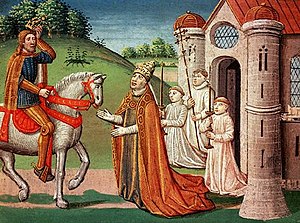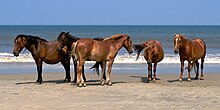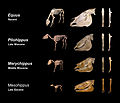The Horses PortalThe horse (Equus ferus caballus) is a domesticated, one-toed, hoofed mammal. It belongs to the taxonomic family Equidae and is one of two extant subspecies of Equus ferus. The horse has evolved over the past 45 to 55 million years from a small multi-toed creature, Eohippus, into the large, single-toed animal of today. Humans began domesticating horses around 4000 BCE, and their domestication is believed to have been widespread by 3000 BCE. Horses in the subspecies caballus are domesticated, although some domesticated populations live in the wild as feral horses. These feral populations are not true wild horses, which are horses that never have been domesticated. There is an extensive, specialized vocabulary used to describe equine-related concepts, covering everything from anatomy to life stages, size, colors, markings, breeds, locomotion, and behavior. Horses are adapted to run, allowing them to quickly escape predators, and possess a good sense of balance and a strong fight-or-flight response. Related to this need to flee from predators in the wild is an unusual trait: horses are able to sleep both standing up and lying down, with younger horses tending to sleep significantly more than adults. Female horses, called mares, carry their young for approximately 11 months and a young horse, called a foal, can stand and run shortly following birth. Most domesticated horses begin training under a saddle or in a harness between the ages of two and four. They reach full adult development by age five, and have an average lifespan of between 25 and 30 years. Horse breeds are loosely divided into three categories based on general temperament: spirited "hot bloods" with speed and endurance; "cold bloods", such as draft horses and some ponies, suitable for slow, heavy work; and "warmbloods", developed from crosses between hot bloods and cold bloods, often focusing on creating breeds for specific riding purposes, particularly in Europe. There are more than 300 breeds of horse in the world today, developed for many different uses. (Full article...) Entries here consist of Good and Featured articles, which meet a core set of high editorial standards.
 Horses in the Middle Ages differed in size, build and breed from the modern horse, and were, on average, smaller. They were also more central to society than their modern counterparts, being essential for war, agriculture, and transport. Consequently, specific types of horse developed, many of which have no modern equivalent. While an understanding of modern horse breeds and equestrianism is vital for any analysis of the medieval horse, researchers also need to consider documentary (both written and pictorial) and archaeological evidence. (Full article...) Selected image This Currier & Ives lithograph from 1867 shows harness racing in sleighs in New York during the 19th century. Latest updates
More did you know?
Related portalsEntries here consist of Good and Featured articles, which meet a core set of high editorial standards.
The Banker horse is a breed of feral horse (Equus ferus caballus) living on barrier islands in North Carolina's Outer Banks. It is small, hardy, and has a docile temperament. Descended from domesticated Spanish horses and possibly brought to the Americas in the 16th century, the ancestral foundation bloodstock may have become feral after surviving shipwrecks or being abandoned on the islands by one of the exploratory expeditions led by Lucas Vázquez de Ayllón or Sir Richard Grenville. Populations are found on Ocracoke Island, Shackleford Banks, Currituck Banks, Cedar Island, and in the Rachel Carson Estuarine Sanctuary. Bankers are allowed to remain on the islands due to their historical significance even though they can trample plants and ground-nesting animals and are not considered to be indigenous. They survive by grazing on marsh grasses, which supply them with water as well as food, supplemented by temporary freshwater pools. (Full article...) Did you know (auto-generated)
General imagesThe following are images from various horse-related articles on Wikipedia.
TopicsHorse • Pony • Asinus • Equus (genus) • Equidae • Zebra • Glossary of equestrian terms • List of horse breeds • Evolution of the horse • Domestication of the horse • Horse care • Stable • Horse training • Equestrianism • Horse tack • Saddle • Equine nutrition • Equine anatomy • Equine conformation • Equine coat color • Equine coat color genetics • Horse markings • Equine vision • Horse hoof • Horseshoe • Horse gait • Horse behavior • Horse breeding • Breed registry • Equine infectious anemia • Horse colic • Lameness • Laminitis • Horse slaughter • Horses in warfare • Arabian horse • Thoroughbred SubcategoriesNew articlesThis list was generated from these rules. Questions and feedback are always welcome! The search is being run daily with the most recent ~14 days of results. Note: Some articles may not be relevant to this project.
Rules | Match log | Results page (for watching) | Last updated: 2025-03-26 20:46 (UTC) Note: The list display can now be customized by each user. See List display personalization for details.
WikiProjectsAssociated WikimediaThe following Wikimedia Foundation sister projects provide more on this subject:
Discover Wikipedia using portals |
Värsked postitused
- Märt-Matis Lill: Lepo Sumera on üks paremaid draamaheliloojaid
- Ramul: raadiosaated, kuhu inimesed saavad helistada, tekitavad eksistentsiaalse üldistuse tunde
- Kui palju peaks kokku varastama
- VIDEO: Ukraina koolides alustati drooniõppega, et sõjaväele kaadrit saada
- Anekdoot: saarel elasid naised, kes mehi jubedalt vihkasid
Most Used Categories
- Arhiiv (8,108)
- Muu (2,873)
- Uudiseid (1,102)
- Huumor (731)
- Kultuur (387)
- Meeldib.ee (169)
- Tervis (101)
- Anekdoodid (42)

































































